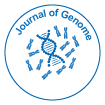Clinical Exomes: Genetic Test for Pediatric Inborn Errors
Received: 28-Apr-2018 / Accepted Date: 30-May-2018 / Published Date: 07-May-2018
Keywords: Genetic background; Genes; Exome sequencing
Editorial
Given their more complex genetic background, approaches to dissect genetic defects in primary immunodeficiency diseases (PID) have been on the front line for the long time. The simplest, reliable and recognized technique used is linkage study, introduced in 1980s for the discovery of disease-causing variants in Huntington’s disease [1]. With the advent of new molecular genetic markers and fast automated genotyping, disease-locus mapping can be organized rapidly through the linkage studies. Linkage is the tendency for genes or DNA sequences to be inherited together in the genome and can be used to map the genes based on given binary and quantitative traits. For the most PID cases for which the underlying genetic defect is remains unknown, the identification of the disease-locus was the initial step in establishing primary diagnosis. Gene-hunting in PID using linkage method is reported for CVID/IgAD on chromosome 16q, close to the marker D16S518 using model-based logarithm of the odds (LOD) score method [2]. There are nevertheless some potential drawbacks of the method. The genetic outcomes are mainly limited to the hereditary diseases that were clinically distinguishable. Furthermore, the complex traits in which polygenic genes are involved had to be employed using linkage method. Whole exome sequencing (WES) technology extends the identification of disease-causing variant of rare diseases especially in PID, which is a valuable guide in response to any biological questions and genetic diagnostic community. The benefits of WES have driven the clinical understanding of human physiology, anatomy and subsequently human diseases to a new dimension of study and thus have made significance improvements in monitoring and health treatment. Understanding the pathogenesis of a disease depends heavily based on the discovery of disease-causing variant and studying the impact of pathogenic variants to the protein structure and level, which is the disease-causing variants, must be related with the reported clinical features. WES is also used to identify rare, novel, as well as common variants in protein-coding area associated with the complex and universal traits. Previously, WES had been used to identify the causative variant of a rare form of inflammatory bowel disease (also known as IBD) in an infant [3]. For this case, conventional clinical diagnostics had failed to find an explanation for the patient’s severe symptoms and clinicians needed to understand the possible cause of the symptoms before they could decide on how to treat the child accordingly. Soon after, WES was done for four patients with Miller Syndrome (MS) with identification of a single candidate gene, known as DHODH. Sanger sequencing confirmed the DHODH mutations in another families with MS and the mutation was absent in the healthy control samples [4]. The robustness and value of WES is emphasized in the study by identification of disease-causing genes in rare genetic disorders with distinct clinical features, which is typically only a few number of people is affected in global. Although WES is widely utilized in clinical diagnostics, there is no gold standard provided for the analysis and identification of disease-causing variants [5]. Sometimes, causative genes may not be found in WES data due to disease variants is predisposed into non-coding regions and outside the targeted regions of WES [6]. In this circumstance, whole genome study should be applied.
References
- Gusella JF, Wexler NS, Conneally PM, Naylor SL, Anderson MA, et al. (1983) A polymorphic DNA marker genetically linked to Huntington's disease. Nature 306: 234- 238.
- Vořechovský I, Zetterquist H, Paganelli R, Koskinen S, David A, et al. (1995) Family and linkage study of selective IgA deficiency and common variable immunodeficiency. Clin Immunol Immunopathol77: 185-192.
- Worthey EA, Mayer AN, Syverson GD, Helbling D, Bonacci BB, et al. (2011) Making a definitive diagnosis: successful clinical application of whole exome sequencing in a child with intractable inflammatory bowel disease. Genet Med 13: 255-262.
- Ng SB, Buckingham KJ, Lee C, Bigham AW, Tabor HK, et al. (2010) Exome sequencing identifies the cause of a mendelian disorder. Nat Genet, 42: 30-35.
- Rehm HL, Bale SJ, Bayrak-Toydemir P, Berg JS, Brown KK, et al. (2013) ACMG clinical laboratory standards for next-generation sequencing. Genet Med 15: 733-747.
- Cirulli ET, Goldstein DB (2010) Uncovering the roles of rare variants in common disease through whole-genome sequencing. Nat Rev Genet 11: 415-425.
Citation: Ghani H (2018) Clinical Exomes: Genetic Test for Pediatric Inborn Errors. J Genome 1: e104.
Copyright: © 2018 Ghani H. This is an open-access article distributed under the terms of the Creative Commons Attribution License, which permits unrestricted use, distribution, and reproduction in any medium, provided the original author and source are credited.
Select your language of interest to view the total content in your interested language
Share This Article
Open Access Journals
Article Usage
- Total views: 2207
- [From(publication date): 0-2018 - Dec 21, 2025]
- Breakdown by view type
- HTML page views: 1437
- PDF downloads: 770
